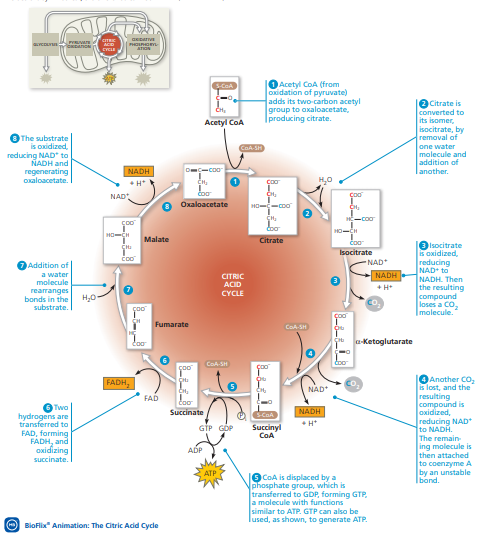CITRIC ATION CYCLE Acetyl CoA (from oxidation of pyruvate) adds its two carbon acetyl group to axaloacetate, Iproducing citrate. 2 Citrate is converted to its isomer, isocitrate, by removal of one water molecule and addition of lanother. Acetyl CoA The substrate is oxidized, reducing NAD* to CaA-SH NADH and regenerating Oxaloacetate. NADH DC-coo H* NAD Oxaloacetate CH -coo HO- HO-CH Malate Citrate 3 Isocitrate is oxidized, reducing NAD to NADH. Then the resulting compound loses a CO, Imolecule. Isocitrate NAD* Addition of NADH + H* a water CITRIC molecule ACID rearranges bonds in the substrate. CYCLE Fumarate CoA SH e a-Ketoglutarate CoA SH Another Co, is lost, and the resulting compound is oxidized, reducing NAD to NADA. The remain ing molecule is then attached to coenzyme A by an unstable Ibond. FADH, FAD CH, NAD Two čoo Succinate NADH hydrogens are transferred to S-CaA +H* GÍP GDP Succinyl CoA FAD, forming FADH, and axidizing succinate. ADP АТР 9 COA is displaced by a phosphate group, which is transferred to GDP, forming GTP, a molecule with functions similar to ATP. GTP can also be lused, as shown, to generate ATP. (O BioFlix" Animation: The Citric Acid Cycle
Electron Transport Chain
The electron transport chain, also known as the electron transport system, is a group of proteins that transfer electrons through a membrane within mitochondria to create a gradient of protons that drives adenosine triphosphate (ATP)synthesis. The cell uses ATP as an energy source for metabolic processes and cellular functions. ETC involves series of reactions that convert redox energy from NADH (nicotinamide adenine dinucleotide (NAD) + hydrogen (H)) and FADH2(flavin adenine dinucleotide (FAD)) oxidation into proton-motive force(PMF), which is then used to synthesize ATP through conformational changes in the ATP synthase complex, a process known as oxidative phosphorylation.
Metabolism
Picture a campfire. It keeps the body warm on a cold night and provides light. To ensure that the fire keeps burning, fuel needs to be added(pieces of wood in this case). When a small piece is added, the fire burns bright for a bit and then dies down unless more wood is added. But, if too many pieces are placed at a time, the fire escalates and burns for a longer time, without actually burning away all the pieces that have been added. Many of them, especially the larger chunks or damp pieces, remain unburnt.
Cellular Respiration
Cellular respiration is the cellular process involved in the generation of adenosine triphosphate (ATP) molecules from the organic nutritional source obtained from the diet. It is a universal process observed in all types of life forms. The glucose (chemical formula C6H12O6) molecules are the preferred raw material for cell respiration as it possesses a simple structure and is highly efficient in nature.
Name the molecules that conserve most of the energy from the

Trending now
This is a popular solution!
Step by step
Solved in 2 steps




